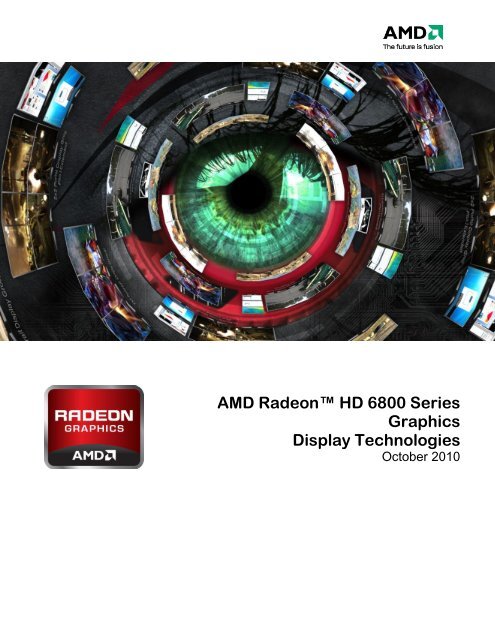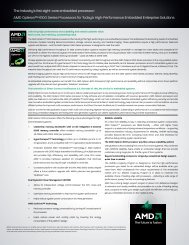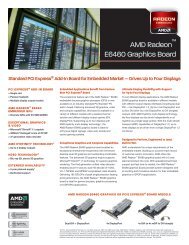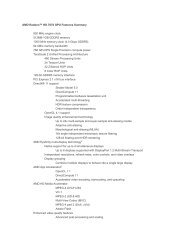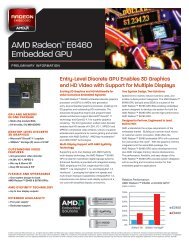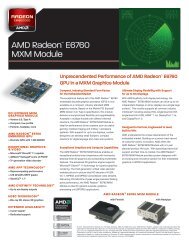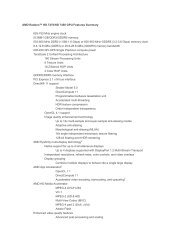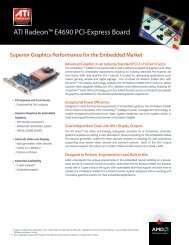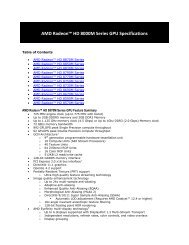AMD Radeon™ HD 6800 Series Display Technologies
AMD Radeon™ HD 6800 Series Display Technologies
AMD Radeon™ HD 6800 Series Display Technologies
Create successful ePaper yourself
Turn your PDF publications into a flip-book with our unique Google optimized e-Paper software.
<strong>AMD</strong> Radeon <strong>HD</strong> <strong>6800</strong> <strong>Series</strong><br />
Graphics<br />
<strong>Display</strong> <strong>Technologies</strong><br />
October 2010
©2010 Advanced Micro Devices, Inc., the <strong>AMD</strong> logo, Radeon, and The Ultimate<br />
Visual Experience are trademarks of Advanced Micro Devices, Inc. Features,<br />
pricing, availability and specifications may vary by product model and are<br />
subject to change without notice. Products may not be exactly as shown.<br />
Table of Contents<br />
INTRODUCTION ........................................................................................................................................... 3<br />
Multi-display <strong>Technologies</strong> ............................................................................................................... 3<br />
Stereoscopic 3D ............................................................................................................................... 3<br />
Wide Color Gamut ............................................................................................................................ 3<br />
DISPLAYPORT 1.2 ................................................................................................................................... 4<br />
High Bit-rate 2 .................................................................................................................................. 5<br />
4k x 2k Resolution ............................................................................................................................ 5<br />
Stereoscopic 3D ............................................................................................................................... 6<br />
Multi-Stream Transport .................................................................................................................... 6<br />
Maximum Eyefinity Resolution ......................................................................................................... 9<br />
High Bit-rate Audio ......................................................................................................................... 10<br />
<strong>AMD</strong> <strong>HD</strong>3D TECHNOLOGY ....................................................................................................................... 11<br />
Frame Sequential <strong>Display</strong>s ............................................................................................................ 12<br />
<strong>HD</strong>MI 1.4a Packed Frame.............................................................................................................. 13<br />
<strong>Display</strong>Port MSA Misc1 Bits .......................................................................................................... 13<br />
Open Ecosystem ............................................................................................................................ 14<br />
COLOR ACCURACY .................................................................................................................................. 15<br />
SUMMARY .................................................................................................................................................. 17<br />
<strong>AMD</strong> Radeon <strong>HD</strong> <strong>6800</strong> <strong>Series</strong> <strong>Display</strong> <strong>Technologies</strong> 2
INTRODUCTION<br />
<strong>Display</strong> devices have always been an integral part of the PC<br />
experience. Whether it is in the form of an external desktop monitor,<br />
a notebook’s embedded panel, or the touch screen of a PC tablet,<br />
display devices play a vital role in defining the user’s visual<br />
experience.<br />
The new display technologies integrated into the <strong>AMD</strong> Radeon<br />
<strong>HD</strong> <strong>6800</strong> series GPUs are targeted to deliver pristine image quality<br />
and impressive performance in three different technologies:<br />
Multi-display <strong>Technologies</strong><br />
<strong>Display</strong>Port 1.2, a new display interface, boasts features such as higher bandwidth and daisychaining<br />
capabilities. Combined, these features complement the <strong>AMD</strong> Eyefinity 1 multi-display<br />
technology very well.<br />
Stereoscopic 3D<br />
The introduction of high refresh rate LCD panels (120Hz and higher) have inspired new stereoscopic<br />
3D display devices for the PC and the CE markets. This whitepaper will explain how the new <strong>AMD</strong><br />
Radeon <strong>HD</strong> <strong>6800</strong> series GPUs enables the PC to deliver a cinematic stereoscopic 3D experience.<br />
Wide Color Gamut<br />
Monitors and notebook with wide color gamut panels, once reserved for the professional market,<br />
have become more prominent with several products shipping in the market. While these types of<br />
LCD panels display a wider range of colors, the drawbacks and challenges will be explained in this<br />
whitepaper, as well as the color gamut remapping technology integrated in the <strong>AMD</strong> Radeon <strong>HD</strong><br />
<strong>6800</strong> series GPUs.<br />
This whitepaper provides an overview of the capabilities and display technologies integrated into the <strong>AMD</strong><br />
Radeon <strong>HD</strong> <strong>6800</strong> series GPUs display engine. These capabilities and technologies, when combined<br />
with cutting edge display devices, deliver the ultimate visual experience.<br />
1 <strong>AMD</strong> Eyefinity technology works with games that support non-standard aspect ratios, which is required for panning across multiple<br />
displays. To enable more than two displays, additional panels with native <strong>Display</strong>Port connectors, and/or <strong>Display</strong>Port compliant<br />
active adapters to convert your monitor’s native input to your cards <strong>Display</strong>Port or Mini-<strong>Display</strong>Port connector(s), are required.<br />
<strong>AMD</strong> Eyefinity technology can support up to 6 displays using a single enabled <strong>AMD</strong> Radeon graphics card with Windows Vista or<br />
Windows 7 operating systems – the number of displays may vary by board design and you should confirm exact specifications with<br />
the applicable manufacturer before purchase. SLS (“Single Large Surface”) functionality requires an identical display resolution on<br />
all configured displays.<br />
©2010 Advanced Micro Devices, Inc., the <strong>AMD</strong> logo, Radeon, and The Ultimate<br />
Visual Experience are trademarks of Advanced Micro Devices, Inc. Features,<br />
pricing, availability and specifications may vary by product model and are<br />
subject to change without notice. Products may not be exactly as shown.<br />
<strong>AMD</strong> Radeon <strong>HD</strong> <strong>6800</strong> <strong>Series</strong> <strong>Display</strong> <strong>Technologies</strong> 3
DISPLAYPORT 1.2<br />
©2010 Advanced Micro Devices, Inc., the <strong>AMD</strong> logo, Radeon, and The Ultimate<br />
Visual Experience are trademarks of Advanced Micro Devices, Inc. Features,<br />
pricing, availability and specifications may vary by product model and are<br />
subject to change without notice. Products may not be exactly as shown.<br />
In 2006, PC manufacturers (including <strong>AMD</strong>) collaborated in designing the next<br />
generation PC display interface, which would eventually be known as<br />
<strong>Display</strong>Port. <strong>Display</strong>Port was designed to replace DVI and VGA by offering<br />
features that are beneficial to both system integrators and end users. It was<br />
also designed to be flexible and easily extensible for new features that the<br />
market will require in the future.<br />
The first generation of <strong>Display</strong>Port provided over 10.8 Gbps of raw bandwidth,<br />
which no other display interface could match. <strong>Display</strong>Port also supported very long non-active cables,<br />
optional latch designs for connectors, and audio support. In addition, with <strong>Display</strong>Port spread spectrum<br />
clocking can be enabled to reduce EMI, and source devices such as GPUs can operate in dual-mode.<br />
The latter is valuable for it allows the same connector to transport TMDS signals to support DVI and<br />
<strong>HD</strong>MI outputs using inexpensive level-shifting adapters.<br />
The data link rates of <strong>Display</strong>Port 1.1a are fixed at either 1.62 Gbps per lane or 2.7 Gbps per lane,<br />
irrespective of the timing of the attached display device. This design only requires a single reference<br />
clock source to drive as many <strong>Display</strong>Port streams as there are display pipelines in the GPU. In contrast,<br />
DVI and <strong>HD</strong>MI both require a dedicated clock source per display timing. This unique <strong>Display</strong>Port feature<br />
allows for the most efficient multi-display design and complements the <strong>AMD</strong> Eyefinity technology. Please<br />
refer to the <strong>AMD</strong> Eyefinity Technology Brief for more information.<br />
All the features of <strong>Display</strong>Port 1.1a proved that it was the superior PC display interface. To further<br />
enhance the <strong>Display</strong>Port interface, the same group of companies collaborated once more to define the<br />
next version of <strong>Display</strong>Port, which paved the way to <strong>Display</strong>Port 1.2.<br />
In early 2010, the <strong>Display</strong>Port 1.2 specification was ratified in VESA. This new revision of the standard<br />
adds support for new and exciting features including High bit-rate audio, even higher bandwidth, and<br />
multi-streaming capabilities.<br />
Just as <strong>AMD</strong> was the first to integrate <strong>Display</strong>Port technology into GPUs with the ATI Radeon <strong>HD</strong> 3000<br />
series, the <strong>AMD</strong> Radeon <strong>HD</strong> <strong>6800</strong> series graphics will be the pioneer GPUs designed to support<br />
<strong>Display</strong>Port 1.2 features. Table 1 is a simplified comparison of display interface capabilities integrated into<br />
<strong>AMD</strong> Radeon <strong>HD</strong> <strong>6800</strong> series GPUs:<br />
<strong>Display</strong>Port 1.2 <strong>Display</strong>Port 1.1a SL-DVI DL-DVI <strong>HD</strong>MI 1.4a<br />
Bandwidth 21.6 Gbps 10.8 Gbps 4.95Gbps 9.9 Gbps 6.75 Gbps<br />
Video Data Rate<br />
Maximum Resolution<br />
17.28 Gbps 8.64 Gbps 3.96 Gbps 7.92 Gbps 5.4 Gbps<br />
Support @ 60Hz<br />
24bpp<br />
>2560x2048 2560x2048 1920x1200 2560x1600 1920x1200<br />
Audio Support Yes Yes No No Yes<br />
Embedded Application<br />
Support<br />
Yes Yes No No No<br />
In-band Stereo 3D<br />
signaling<br />
Yes Yes No No Yes<br />
Multi-stream support Yes No No No No<br />
Table 1: <strong>Display</strong> interface capabilities of the <strong>AMD</strong> Radeon <strong>HD</strong> <strong>6800</strong> series GPUs<br />
<strong>AMD</strong> Radeon <strong>HD</strong> <strong>6800</strong> <strong>Series</strong> <strong>Display</strong> <strong>Technologies</strong> 4
High Bit-rate 2<br />
<strong>Display</strong>Port 1.2 supports up to twice the bandwidth of <strong>Display</strong>Port 1.1a. High Bit-rate 2 (HBR2) provides<br />
up to 5.4 Gbps/lane of bandwidth, or up to 21.6 Gbps in a full four lane configuration. This lends itself<br />
very well to many applications that require ultra-high bandwidth.<br />
Chart 1 illustrates the wide range of display timings (resolution, refresh rate, and color depth) supported<br />
by various digital display interfaces.<br />
Chart 1: Comparison of video data rate versus resolution at different refresh rates and color depths<br />
As illustrated in Chart 1, <strong>Display</strong>Port 1.2 can easily support a multitude of display timings combining high<br />
resolutions, high refresh rates and high color depth. No other PC display interface can match this<br />
capability today.<br />
4k x 2k Resolution<br />
Ultra-high resolution projectors have existed for years but<br />
were targeted for professional applications. 4K TVs have<br />
also started appearing in many tradeshows and<br />
demonstration events. In the future, <strong>AMD</strong> envisions TVs<br />
and monitors supporting significantly higher resolutions, well<br />
above WQXGA (2560x1600). There are different proposals<br />
for 4k resolutions such as 3840x2160 and 4096x2160, both<br />
well over 8 MPixels. The only PC display interface that can<br />
meet the high bandwidth requirement to drive such displays<br />
and support a refresh rate of 60Hz is <strong>Display</strong>Port 1.2.<br />
Although <strong>Display</strong>Port 1.2 HBR2 can easily accommodate resolutions up to 4096x2160 @ 60Hz, the <strong>AMD</strong><br />
Radeon <strong>HD</strong> <strong>6800</strong> series GPUs are designed to support up to 4096x2160 @ 50Hz.<br />
©2010 Advanced Micro Devices, Inc., the <strong>AMD</strong> logo, Radeon, and The Ultimate<br />
Visual Experience are trademarks of Advanced Micro Devices, Inc. Features,<br />
pricing, availability and specifications may vary by product model and are<br />
subject to change without notice. Products may not be exactly as shown.<br />
<strong>AMD</strong> Radeon <strong>HD</strong> <strong>6800</strong> <strong>Series</strong> <strong>Display</strong> <strong>Technologies</strong> 5
Stereoscopic 3D<br />
Frame sequential 3D displays are those that display one view at a<br />
time (left or right) and require the use of liquid crystal shutter glasses.<br />
According to Stereo 3D experts, at least 60fps (or 60Hz) per eye is<br />
required for these types of displays to have a pleasant 3D<br />
experience. This means that the minimum total refresh rate required<br />
is 120Hz. Only <strong>Display</strong>Port 1.2 has enough bandwidth to drive<br />
display timings required for high resolution frame sequential 3D<br />
displays, and also removes the need for buffering.<br />
Multi-Stream Transport<br />
Leveraging the micro-packet architecture of <strong>Display</strong>Port, <strong>Display</strong>Port 1.2 adds the capability to address<br />
and drive several display devices through one <strong>Display</strong>Port connector. This feature has often been<br />
referred to as daisy-chaining or addressable displays.<br />
Multi-stream transport, or MST for short, can be leveraged using two types of system design. Figure 2<br />
illustrates how MST can be used with daisy-chainable monitors. Each of the monitors in the daisy-chain<br />
configuration, with the exception of the last monitor in the chain, must have <strong>Display</strong>Port receiver(s) and<br />
transmitter(s) in order to receive the video stream that is addressed to itself and the others down the<br />
chain. Once the monitor extracts the video and audio stream addressed to it, it will then transmit the rest<br />
of the video and audio streams down the chain. Each daisy-chainable monitor must have knowledge of<br />
the entire chain.<br />
©2010 Advanced Micro Devices, Inc., the <strong>AMD</strong> logo, Radeon, and The Ultimate<br />
Visual Experience are trademarks of Advanced Micro Devices, Inc. Features,<br />
pricing, availability and specifications may vary by product model and are<br />
subject to change without notice. Products may not be exactly as shown.<br />
Figure 2: Daisy-chaining monitors<br />
Figure 3 illustrates the alternate method of utilizing MST to drive multiple displays through the use of MST<br />
Hub or Splitter devices. The hub device receives a <strong>Display</strong>Port 1.2 MST signal from the source device<br />
and splits out the video streams independently to each display device. Using this type of configuration<br />
also allows the use of non <strong>Display</strong>Port 1.2 monitors. To support non <strong>Display</strong>Port outputs, such as VGA,<br />
DVI or <strong>HD</strong>MI, the hub or splitter must have the capability to convert the <strong>Display</strong>Port signal to the other<br />
types of display interface signals.<br />
<strong>AMD</strong> Radeon <strong>HD</strong> <strong>6800</strong> <strong>Series</strong> <strong>Display</strong> <strong>Technologies</strong> 6
©2010 Advanced Micro Devices, Inc., the <strong>AMD</strong> logo, Radeon, and The Ultimate<br />
Visual Experience are trademarks of Advanced Micro Devices, Inc. Features,<br />
pricing, availability and specifications may vary by product model and are<br />
subject to change without notice. Products may not be exactly as shown.<br />
Figure 3: Using MST Hub or splitter<br />
The number of display devices, and also the timings that each display device can be driven at will depend<br />
on the available bandwidth. Table 2 lists the multi-display configurations possible with HBR and HBR2<br />
bandwidth:<br />
HBR HBR2<br />
1366x768 @ 60Hz, 24bpp Up to 5 Up to 6 2<br />
1600x900 @ 60Hz, 24bpp Up to 3 Up to 6 2<br />
1920x1080 @ 60Hz, 24bpp Up to 2 Up to 4<br />
2560x1440 @ 60Hz, 24bpp 1 Up to 2<br />
Table 2: Comparison of <strong>Display</strong>Port bandwidth vs number of displays<br />
In 2009, <strong>AMD</strong> first announced the Eyefinity Multi-display<br />
feature. This differentiating feature has been well received by<br />
reviewers and end-users alike. While the appeal is mainly for<br />
ultra-wide screen and high resolution gaming, this feature<br />
also caters to those looking to increase their productivity<br />
through multi-monitor configurations. The <strong>AMD</strong> Radeon <strong>HD</strong><br />
<strong>6800</strong> series will be the first GPUs to extend the capabilities of<br />
Eyefinity with <strong>Display</strong>Port 1.2 MST.<br />
Using daisy-chainable displays or MST hubs significantly<br />
extends the number of display configurations possible with a reference board design that has at least one<br />
<strong>Display</strong>Port 1.2 connector. For example, with the ATI Radeon <strong>HD</strong> 5000 <strong>Series</strong> GPUs, six-display<br />
configurations are only possible using six <strong>Display</strong>Port 1.1a connectors. This was realized with the<br />
acclaimed ATI Radeon <strong>HD</strong> 5890 Eyefinity 6 Edition graphics card.<br />
2 HBR2 bandwidth can support more than six displays with this specific timing, but the <strong>AMD</strong> Radeon <strong>HD</strong> <strong>6800</strong> <strong>Series</strong> GPUs<br />
support up to a maximum of six independent displays<br />
<strong>AMD</strong> Radeon <strong>HD</strong> <strong>6800</strong> <strong>Series</strong> <strong>Display</strong> <strong>Technologies</strong> 7
Figure 4: ATI Radeon <strong>HD</strong> 5890 Eyefinity 6 Edition driving six displays with six mini-DP connectors<br />
As an example of how to combine MST and <strong>AMD</strong> Eyefinity technology, consider figure 5. Using an MST<br />
hub, which is expected to be available in 2011, even the <strong>AMD</strong> Radeon <strong>HD</strong> 6870 reference board can<br />
drive up to six displays using only two <strong>Display</strong>Port connectors. This provides an upgrade path for endusers<br />
who have three monitors today, but may want to upgrade to five or six monitors in the future.<br />
©2010 Advanced Micro Devices, Inc., the <strong>AMD</strong> logo, Radeon, and The Ultimate<br />
Visual Experience are trademarks of Advanced Micro Devices, Inc. Features,<br />
pricing, availability and specifications may vary by product model and are<br />
subject to change without notice. Products may not be exactly as shown.<br />
Figure 5: Using MST Hub to drive six displays<br />
Aside from multi-output hubs, there will likely be less expensive <strong>Display</strong>Port 1.2 MST dongles in the<br />
market, which support two display outputs. Figure 6 illustrates how you can still support up to six displays<br />
using two of these dongles combined with the DVI or <strong>HD</strong>MI display outputs on the graphics card.<br />
<strong>AMD</strong> Radeon <strong>HD</strong> <strong>6800</strong> <strong>Series</strong> <strong>Display</strong> <strong>Technologies</strong> 8
Figure 6: Using MST dongles and legacy outputs on graphics card to drive six displays<br />
Maximum Eyefinity Resolution<br />
The ATI Radeon <strong>HD</strong> 5000 series GPUs supported a maximum Eyefinity resolution of 8k pixels wide by<br />
8k pixels high. The <strong>AMD</strong> Radeon <strong>HD</strong> <strong>6800</strong> series GPUs removes this limitation and supports a<br />
maximum Eyefinity resolution of 16kx16k, which enables new usage scenarios. Figure 7 shows one<br />
example of an Eyefinity configuration which would not have been supported with previous generation<br />
GPUs<br />
Figure 7: <strong>AMD</strong> Eyefinity configuration that exceeds 8kx8k limitation but supported by <strong>AMD</strong> Radeon <strong>HD</strong><br />
<strong>6800</strong> series GPUs<br />
There are other possible configurations that can be supported by the <strong>AMD</strong> Radeon <strong>HD</strong> <strong>6800</strong> series<br />
GPUs combined with <strong>Display</strong>Port 1.2 MST monitors, hubs and dongles. Please note that to take<br />
advantage of this feature, Windows® 7 Aero glass must be disabled. In addition, only DirectX® 11<br />
games allow resolutions above 8kx8k pixels.<br />
©2010 Advanced Micro Devices, Inc., the <strong>AMD</strong> logo, Radeon, and The Ultimate<br />
Visual Experience are trademarks of Advanced Micro Devices, Inc. Features,<br />
pricing, availability and specifications may vary by product model and are<br />
subject to change without notice. Products may not be exactly as shown.<br />
<strong>AMD</strong> Radeon <strong>HD</strong> <strong>6800</strong> <strong>Series</strong> <strong>Display</strong> <strong>Technologies</strong> 9
High Bit-rate Audio<br />
Radeon GPUs have supported pass-through audio through <strong>HD</strong>MI since the ATI Radeon <strong>HD</strong> 2000<br />
series GPUs, without external audio cabling. In 2009, <strong>AMD</strong> released the ATI Radeon <strong>HD</strong> 4700, 4600<br />
and 4500 and 4300 series GPUs which were the first GPUs to support audio through <strong>Display</strong>Port. Today,<br />
there are several <strong>Display</strong>Port monitors in the market that can take advantage of this feature, all of which<br />
have the option of attaching external speakers or a sound bar to the monitor.<br />
Although <strong>Display</strong>Port 1.1a supports audio, the specification did not have provision to support high bit-rate<br />
compressed audio formats, such as those found in Blu-ray movies. <strong>Display</strong>Port 1.2 adds this capability<br />
and the <strong>AMD</strong> Radeon <strong>HD</strong> <strong>6800</strong> series will be the first GPUs in the market to support High bit-rate audio<br />
through <strong>Display</strong>Port. Table 3 lists the high bit-rate audio formats found in premium content, now<br />
supported through <strong>Display</strong>Port 1.2:<br />
DTS-<strong>HD</strong> Master Audio Dolby True<strong>HD</strong> PCM 7.1ch<br />
Bitrate Up to 24 Mbps Up to 18Mbps Up to 36 Mbps<br />
Bits/Sample 24 bits/sample 24 bits/sample 24 bits/sample<br />
Sampling Rate Up to 192 kHz Up to 192 kHz Up to 192 kHz<br />
Channels Up to 8 Up to 8 Up to 8<br />
Table 3: Compressed and uncompressed audio formats supported through <strong>Display</strong>Port 1.2<br />
This capability is attractive to HTPC enthusiasts who want the latest in audio technologies in the market.<br />
©2010 Advanced Micro Devices, Inc., the <strong>AMD</strong> logo, Radeon, and The Ultimate<br />
Visual Experience are trademarks of Advanced Micro Devices, Inc. Features,<br />
pricing, availability and specifications may vary by product model and are<br />
subject to change without notice. Products may not be exactly as shown.<br />
<strong>AMD</strong> Radeon <strong>HD</strong> <strong>6800</strong> <strong>Series</strong> <strong>Display</strong> <strong>Technologies</strong> 10
<strong>AMD</strong> <strong>HD</strong>3D TECHNOLOGY<br />
Stereoscopic 3D is a technique of creating the illusion of depth using a stereo image pair. Each image<br />
represents the scene as viewed by the left or the right eye. The illusion of depth is achieved when the<br />
display device (along with the passive polarized and active glasses in most 3D systems) is able to<br />
present the left image only to the left eye and the right image to the right eye. To fully understand how<br />
<strong>AMD</strong> <strong>HD</strong>3D technology can deliver stunning 3D images, it is helpful to first examine the Stereoscopic 3D<br />
gaming pipeline.<br />
The majority of DirectX® games available in the market do not support stereo 3D natively. This means<br />
that the stereo image pair must be generated external to the game engine. This can be achieved with<br />
third party stereo 3D conversion software, such as iZ3D or Dynamic Digital Depth’s gaming driver.<br />
The stereo 3D conversion software intercepts DirectX® calls from the game. Using these calls, the<br />
stereo 3D conversion software generates the stereo image pair, or the Left and Right eye view. For<br />
certain types of 3D displays, the stereo 3D conversion software blends the two views together to form a<br />
single frame using a format that the display supports (e.g. Row interleave, checkerboard, side-by-side,<br />
etc…). Once the frame is in the correct format, the stereo 3D conversion software sends the frame to the<br />
GPU, which will then be sent to the 3D display device.<br />
©2010 Advanced Micro Devices, Inc., the <strong>AMD</strong> logo, Radeon, and The Ultimate<br />
Visual Experience are trademarks of Advanced Micro Devices, Inc. Features,<br />
pricing, availability and specifications may vary by product model and are<br />
subject to change without notice. Products may not be exactly as shown.<br />
Figure 8: Stereo 3D conversion software architecture<br />
<strong>AMD</strong> Radeon <strong>HD</strong> <strong>6800</strong> <strong>Series</strong> <strong>Display</strong> <strong>Technologies</strong> 11
Frame Sequential <strong>Display</strong>s<br />
Frame sequential 3D displays (also known as page flipped displays) require special treatment. To<br />
support frame sequential 3D displays, the output of the stereo 3D conversion software is also frame<br />
sequential and does not need to be converted into any of the formats illustrated in Figure 8. However,<br />
the stereo 3D conversion software requires a new API known as <strong>AMD</strong>’s quad buffer.<br />
Figure 9: Stereo 3D conversion software architecture using <strong>AMD</strong>’s quad buffer<br />
<strong>AMD</strong>’s quad buffer API provides the infrastructure for stereo 3D conversion software to support frame<br />
sequential 3D displays by creating a double-height buffer using the existing front & back buffer in<br />
DirectX®. After the stereo 3D conversion software stores the left and right images in the quad buffer,<br />
they are fetched by the display engine which ensures that the frames remain in ordered sequence<br />
throughout the pipeline. Before the frames are transmitted, the display engine formats the output to<br />
provide frame polarity information to the display device. Two standardized methods of conveying frame<br />
polarity information are supported by the Radeon <strong>HD</strong> <strong>6800</strong> series GPUs. These will be described in<br />
the next section.<br />
For more information regarding <strong>AMD</strong>’s quad buffer API, please visit http://developer.amd.com.<br />
©2010 Advanced Micro Devices, Inc., the <strong>AMD</strong> logo, Radeon, and The Ultimate<br />
Visual Experience are trademarks of Advanced Micro Devices, Inc. Features,<br />
pricing, availability and specifications may vary by product model and are<br />
subject to change without notice. Products may not be exactly as shown.<br />
<strong>AMD</strong> Radeon <strong>HD</strong> <strong>6800</strong> <strong>Series</strong> <strong>Display</strong> <strong>Technologies</strong> 12
<strong>HD</strong>MI 1.4a Packed Frame<br />
The <strong>HD</strong>MI 1.4a specification has provision on how to support<br />
Stereo 3D display devices. This specification provides a<br />
mechanism for the source device, in this case the GPU, to<br />
convey frame polarity information, while maintaining full<br />
resolution. There are several Stereo 3D TVs in the market<br />
today that support the <strong>HD</strong>MI 1.4a specification.<br />
Similar to <strong>AMD</strong>’s quad buffer described in the preceding<br />
section, for every stereo image pair, the output frame is<br />
organized in a standard format known as packed frame. The<br />
GPU creates a buffer that is twice the height of the resolution of<br />
the frame, with active space in between frames. As per the<br />
spec, the left frame is always on top, and the right frame is at<br />
the bottom of the packed frame.<br />
After this packed frame is assembled, the GPU will send it over<br />
the <strong>HD</strong>MI link as a packed frame. Once the TV receives this<br />
packed frame, it unpacks the frame and presents it to the<br />
viewer in a frame sequential or page flipped manner. Since the polarity of each frame is known, the<br />
display can then control the emitter to send the correct signal to the shutter glasses.<br />
The <strong>AMD</strong> Radeon <strong>HD</strong> <strong>6800</strong> series GPUs, as well as the new LCD 3D TVs productized in 2010, support<br />
the following packed frame 3D modes specified in the <strong>HD</strong>MI 1.4a specification:<br />
1920x1080 @ 24Hz ( 48Hz total )<br />
1280x720 @ 60Hz ( 120Hz total )<br />
1280x720 @ 50Hz ( 100Hz total )<br />
<strong>Display</strong>Port MSA Misc1 Bits<br />
The <strong>Display</strong>Port standard specifies a method in which the source<br />
device can send frame polarity information through the <strong>Display</strong>Port<br />
link. This method is often referred to as the MSA method. MSA<br />
(Main stream attribute) is a secondary packet sent by the GPU to<br />
the display device, which is transmitted during the vertical blanking<br />
interval. This table shows how the GPU sets the MISC1 bits for left<br />
and right images.<br />
©2010 Advanced Micro Devices, Inc., the <strong>AMD</strong> logo, Radeon, and The Ultimate<br />
Visual Experience are trademarks of Advanced Micro Devices, Inc. Features,<br />
pricing, availability and specifications may vary by product model and are<br />
subject to change without notice. Products may not be exactly as shown.<br />
MSA MISC1<br />
Bits<br />
Bit 2 Bit 1<br />
No Stereo Video 0 0<br />
Video Frame is Right 0 1<br />
Reserved 1 0<br />
Video Frame is Left 1 1<br />
<strong>AMD</strong> Radeon <strong>HD</strong> <strong>6800</strong> <strong>Series</strong> <strong>Display</strong> <strong>Technologies</strong> 13
Due to the high bandwidth requirement of Stereo 3D as well as the MSA method for signaling, monitor<br />
vendors are designing their next generation Stereo 3D monitors to support <strong>Display</strong>Port. These monitors<br />
should be available next year, and the <strong>AMD</strong> Radeon <strong>HD</strong> <strong>6800</strong> series are the first GPUs that are ready<br />
to support these monitors. This method is also applicable to embedded <strong>Display</strong>Port to support embedded<br />
stereo 3D panels for notebook and All-in-one platforms.<br />
The <strong>AMD</strong> Radeon <strong>HD</strong> <strong>6800</strong> series GPUs also support stereo 3D video playback. The stereo 3D video<br />
pipeline is similar to the gaming pipeline, where a third party application is required to convert 2D content<br />
to 3D, or to decode native Stereo 3D content. These applications also convert the format of the frame,<br />
depending on the type of 3D display device attached to the PC.<br />
©2010 Advanced Micro Devices, Inc., the <strong>AMD</strong> logo, Radeon, and The Ultimate<br />
Visual Experience are trademarks of Advanced Micro Devices, Inc. Features,<br />
pricing, availability and specifications may vary by product model and are<br />
subject to change without notice. Products may not be exactly as shown.<br />
Figure 10: Stereo 3D Video pipeline<br />
The <strong>AMD</strong> Radeon <strong>HD</strong> <strong>6800</strong> series GPUs support the following new features:<br />
UVD accelerated MVC Decode for Blu-ray 3D movies<br />
Windowed mode playback of Blu-ray 3D movies through <strong>HD</strong>MI and <strong>Display</strong>Port<br />
Clone mode 3D movie playback<br />
For more information, please refer to the <strong>AMD</strong> Video <strong>Technologies</strong> technical whitepaper.<br />
Open Ecosystem<br />
<strong>AMD</strong> promotes open ecosystems. Working with display and shutter glass vendors, software vendors and<br />
others, will ensure the highest level of interoperability with the software and hardware devices in the<br />
market. The technologies described in this section, including industry display standards, not only enable<br />
a multitude of solutions in the market - they also allow partners to innovate and improve upon current<br />
technology.<br />
<strong>AMD</strong> Radeon <strong>HD</strong> <strong>6800</strong> <strong>Series</strong> <strong>Display</strong> <strong>Technologies</strong> 14
COLOR ACCURACY<br />
Color gamut is the range of colors that can be represented by a display device. The most common<br />
method of illustrating a display device’s color gamut is by using a gamut diagram, similar to figure 11.<br />
The supported color gamut of the display is represented as the area bounded usually by a triangle - in<br />
this case labeled sRGB.<br />
Figure 11: – Color gamut diagram for sRGB<br />
The majority of display devices in the past had the capability to fully display the sRGB color gamut.<br />
(Note: This is usually advertised as 72% NTSC). In addition, the majority of content are also captured in<br />
sRGB color gamut, including pictures and videos. Even the Microsoft Windows® desktop is rendered in<br />
sRGB color gamut.<br />
Today, there are LCD monitors in the market that can display a color gamut greater than sRGB. Some<br />
monitors can cover 80% NTSC, while professional monitors can cover Adobe RGB ( 92% NTSC) or more.<br />
The problem arises when the end user views sRGB content on wide color gamut monitors without color<br />
correction - the colors become distorted and over saturated in most cases. This problem can be<br />
addressed by a process called color correction or color gamut remapping.<br />
©2010 Advanced Micro Devices, Inc., the <strong>AMD</strong> logo, Radeon, and The Ultimate<br />
Visual Experience are trademarks of Advanced Micro Devices, Inc. Features,<br />
pricing, availability and specifications may vary by product model and are<br />
subject to change without notice. Products may not be exactly as shown.<br />
Figure 12: Difference between corrected and uncorrected image 3<br />
3 Simulated saturation to show the difference between color corrected and uncorrected image on wide gamut panels<br />
<strong>AMD</strong> Radeon <strong>HD</strong> <strong>6800</strong> <strong>Series</strong> <strong>Display</strong> <strong>Technologies</strong> 15
While the uncorrected image may seem more vivid, some of the colors look unnatural - especially flesh<br />
tone colors. One can imagine the problem this would cause in professional graphics applications where<br />
color accuracy is paramount. Even for mainstream consumers, uncorrected color images could lead to<br />
frustration for those who print photos at home, or those who view and purchase items through the<br />
internet.<br />
Previous generation GPUs, for example the ATI Radeon <strong>HD</strong> 5000 series, had the capability to perform<br />
gamut remapping. However, the capability had a limitation, in that the color gamut remapping or color<br />
correction is performed in non-linear space (i.e. gamma space). This limits the precision and accuracy of<br />
the color gamut remapping process.<br />
The <strong>AMD</strong> Radeon <strong>HD</strong> <strong>6800</strong> series GPUs remove this limitation by performing the color gamut<br />
remapping in linear space, as illustrated in figure 13:<br />
Previous Generation<br />
GPUs<br />
<strong>AMD</strong> Radeon <strong>HD</strong><br />
<strong>6800</strong> <strong>Series</strong> GPUs<br />
©2010 Advanced Micro Devices, Inc., the <strong>AMD</strong> logo, Radeon, and The Ultimate<br />
Visual Experience are trademarks of Advanced Micro Devices, Inc. Features,<br />
pricing, availability and specifications may vary by product model and are<br />
subject to change without notice. Products may not be exactly as shown.<br />
Figure 13: Comparison of color gamut remapping hardware<br />
Adding the de-gamma step in the display engine and an advanced gamut remapping algorithm ensure<br />
high precision color gamut remapping throughout the pipeline, resulting in excellent color reproduction<br />
even on wide gamut panels. In addition, since the color gamut remapping process is performed by the<br />
display engine hardware and not through software, it will not incur any performance penalty and can be<br />
applied to full screen and windowed applications.<br />
<strong>AMD</strong> plans to publish an API that can take advantage of this new hardware capability, along with SDK<br />
documentation. These will soon be available for application developers at http://developer.amd.com.<br />
<strong>AMD</strong> Radeon <strong>HD</strong> <strong>6800</strong> <strong>Series</strong> <strong>Display</strong> <strong>Technologies</strong> 16
SUMMARY<br />
<strong>AMD</strong> is a recognized industry leader in display technologies, providing innovation through introduction of<br />
new technologies and display interfaces in our products. The <strong>AMD</strong> Radeon <strong>HD</strong> <strong>6800</strong> series GPUs<br />
marks the introduction of several key display technologies:<br />
First GPU to support <strong>Display</strong>Port 1.2 Multi-Streaming<br />
First GPU to support both <strong>Display</strong>Port and <strong>HD</strong>MI 1.4a for stereoscopic 3D<br />
First GPU to support enhanced color gamut remapping for wide color gamut displays<br />
The <strong>AMD</strong> Radeon <strong>HD</strong> <strong>6800</strong> series GPUs combine <strong>Display</strong>Port 1.2 and <strong>AMD</strong> Eyefinity technology to<br />
deliver the most flexible and immersive multi-display experience. Support for Stereoscopic 3D using next<br />
generation display interfaces will enable end users to bring home the cinematic 3D experience once<br />
reserved for theatres. Finally, end users can now take advantage of accurate color reproduction with the<br />
improved color gamut remapping capabilities of these new GPUs. All these features combined, positions<br />
the <strong>AMD</strong> Radeon <strong>HD</strong> <strong>6800</strong> series as the GPUs of choice for HTPC enthusiasts and gamers alike.<br />
©2010 Advanced Micro Devices, Inc., the <strong>AMD</strong> logo, Radeon, and The Ultimate<br />
Visual Experience are trademarks of Advanced Micro Devices, Inc. Features,<br />
pricing, availability and specifications may vary by product model and are<br />
subject to change without notice. Products may not be exactly as shown.<br />
<strong>AMD</strong> Radeon <strong>HD</strong> <strong>6800</strong> <strong>Series</strong> <strong>Display</strong> <strong>Technologies</strong> 17
©2010 Advanced Micro Devices, Inc., the <strong>AMD</strong> logo, Radeon, and The Ultimate<br />
Visual Experience are trademarks of Advanced Micro Devices, Inc. Features,<br />
pricing, availability and specifications may vary by product model and are<br />
subject to change without notice. Products may not be exactly as shown.<br />
DISCLAIMER<br />
The information presented in this document is for informational purposes only and may contain technical<br />
inaccuracies, omissions and typographical errors. <strong>AMD</strong> reserves the right to revise this information and to<br />
make changes from time to time to the content hereof without obligation of <strong>AMD</strong> to notify any person of<br />
such revisions or changes.<br />
<strong>AMD</strong> MAKES NO REPRESENTATIONS OR WARRANTIES WITH RESPECT TO THE CONTENTS<br />
HEREOF AND ASSUMES NO RESPONSIBILITY FOR ANY INACCURACIES, ERRORS OR<br />
OMISSIONS THAT MAY APPEAR IN THIS INFORMATION. <strong>AMD</strong> SPECIFICALLY DISCLAIMS ANY<br />
IMPLIED WARRANTIES OF MERCHANTABILITY OR FITNESS FOR ANY PARTICULAR PURPOSE.<br />
IN NO EVENT WILL <strong>AMD</strong> BE LIABLE TO ANY PERSON FOR ANY DIRECT, INDIRECT, SPECIAL OR<br />
OTHER CONSEQUENTIAL DAMAGES ARISING FROM THE USE OF ANY INFORMATION<br />
CONTAINED HEREIN, EVEN IF <strong>AMD</strong> IS EXPRESSLY ADVISED OF THE POSSIBILITY OF SUCH<br />
DAMAGES.<br />
Copyright 2010, Advanced Micro Devices Inc. All rights reserved. <strong>AMD</strong>, the <strong>AMD</strong> Arrow logo, ATI, the<br />
ATI logo, Radeon, and combinations thereof are trademarks of Advanced Micro Devices, Inc. Other<br />
names are used for informational purposes only and may be trademarks of their respective owners.<br />
<strong>AMD</strong> Radeon <strong>HD</strong> <strong>6800</strong> <strong>Series</strong> <strong>Display</strong> <strong>Technologies</strong> 18


